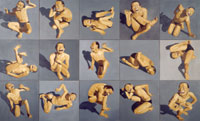I've had reservations about kitschy objects since I was a young child. I am not very sentimental and I have always found large kitschy things, such as parade floats, particularly creepy. I doubt that I will ever find myself enthusiastic for the stuff, but I am interested in it nonetheless (So long as I don‘t have to own any). I am more intrigued by kitsch now, having read Betty Spackman‘s book, A Profound Weakness: Christians and Kitsch, who raises some interesting questions about its nature and purpose. The love/hate relationship, or love-to-hate relationship, of arts-conscious people and kitsch has increased in popularity over recent years on account of artists such as Jeff Koons, Odd Nerdrum, and Pepon Osorio. For better or worse, these artists are at the forefront of elevating mass produced objects, which were previously considered base, to the level of high art.*
What is kitsch? If you are an American, and have spent any time at all using your sensory organs while you live, I guarantee that you are familiar with the stuff more than you know--and have been since childhood. Kitsch is a word with German roots, shortened from the word kitschen, which means gaudy trash or to smear. The word was popularized in the 1930’s by the art theorists Clement Greenberg, Theodor Adorno, and Hermann Broch. They used the term to describe low art--objects created pretentiously, but with the artistic deficiency--art created in bad taste. They saw kitsch as the antithesis of the avant-guarde. Often kitsch includes mass-produced objects, replicas of artworks traditionally considered great, and extremely sentimental works, created for their nostalgic appearance. Kitsch, like craft, is formulaic, and contingent upon a prescribed regimen of copying, high art. Kitsch is imitative and lacks a sense of creativity. Some common examples of kitsch, which might help acquaint someone with the term, are velvet paintings of Elvis, John Wayne, Jesus, Native Americans, wolves, or Dale Earnhardt, McDonalds happy-meal toys, garden gnomes, replicas of the Venus de Milo, Dutch children salt and pepper shakers made in China, Thomas Kinkade paintings, and the inspirational posters in dentists offices of waterfalls with quotes to the effect of “If you fall…try, try again.”**
What can be the purpose of kitsch? Two weeks ago I would have flippantly responded, “NOTHING! It’s all marketing, all propaganda, all ploys to gain a buck from people who aren’t creative enough to create their own souvenirs with their imaginations! I am appalled!”*** But in fact, kitsch has a purpose unique unto itself. Consider an example that Spackman gives in A Profound Weakness. She has a souvenir of Canada. What is a souvenir of Canada? In this case, it is a small pink plastic bunny, with an eerily large proportioned head and pair of front teeth. The rabbit wears a huge bow tie, red with white polka-dots. The platform for the plastic caricature is a flat cut of a tree branch. The wooden disc also serves as the base for the sign perched next to the bunny, which reads, “Souvenir of Canada.” Of course, as Spackman points out, this bizarre combination of elements has nothing to do with Canada at all--for Mounties have yet to discover pink bunnies inhabiting the Canadian expanse. However, the object does not bear the responsibility to accurately render the Canadian experience. Rather, its existence serves to jog the memory of the keepsake’s owner, and it promotes dialogue about memories made in Canada--or at least, memories about the garage sell bin where the owner discovered the tacky item. The in vogue response to kitschy objects is a stuffy frown. As I have already admitted, I am inclined to do my share of scowling, but Spackman has challenged me, scowls and all. I am now more inclined to see the unfairness of the kitsch/fine art comparison. In many cases, kitsch isn’t created to be considered fine art, neither were African tribal masks, nor the cave paintings at Lascaux, France. (I believe that intention is crucial in classifying art.)
In the same way, kitsch isn’t about the artistic integrity, technical execution, image accuracy, or precious rarity of the object. Kitsch is about the narrative which flows from the item. The more meaning communicated on account of the base craft piece, the more valuable the kitsch. Kitsch has a completely different economy than art; the object’s value is intimately connected to dialogue or personal reflection. Consequently, it is not in our interest to demand kitsch to fill the place of art--we should evaluate kitsch as kitsch--a placeholder for memories, a vessel of meaning. Maybe this is why some people have amassed house loads of kitschy souvenirs. Kitsch says more about the person’s preference in memory-keeping than it says about itself.
So, what is the problem? Why does kitsch have a bad reputation and why do some art-snobs snub its existence? Reasons vary. There is a one reason that stands out to me from my Protestant standpoint. (I admit that this may seem to be only an irrational fear, but if you are interested check out .) When kitsch is available to people who are not exposed to the fine arts--the art of great masters and contemporary masterpieces of all mediums--kitsch defaults to the position of fine art in their environments, whether or not there is memory and narrative attached to the objects. I believe that this is an undesirable result because kitsch has a limited nature. Whereas fine art is vast, limited only by its medium, and able to convey universal truths, kitsch cannot boast of such lofty achievements. The very definition of kitsch is uneducated, primitive in its technical execution. It is an orphaned creation, estranged from meaning, when separated from its owner. Kitsch relies on outside explanations, but fine art provides us the explanation within itself.
*Theirs’ is a part of the longstanding artistic approach to kitsch, the roots of such a concept were nurtured by Warhol's “Brillo Box” and his prints of tomato soup cans, and earlier still, by Duchamp's “Fountain,” his comb, and his shovel. Of course, there may be many similar approaches throughout art history--something I would like to look into further, but simply haven’t the time to invest at this juncture. Here’s to the future existence of a post about the kitsch of the ancients--cheers!
**If this brief paragraph on kitsch interests you, and you like art history, I recommend checking out Clement Greenberg’s essay, “Avant-Gaurde and Kitsch.” Along with Greenberg's academic response to kitsch, an art critic who was very much a part of the face of the Modernists, I would also recommend reading Odd Nerdrum’s manifesto, On Kitsch. Nerdrum proclaimed that he was not an artist, but rather a painter of kitsch. I think now most critics would agree that Kinkade is more accurately the “painter of kitsch” and Nerdrum the “painter of light,” if those were the only two labels that artists could vie for.
***The Czech writer, Milan Kundera, in his book The Unbearable Lightness of Being, wrote "Whenever a single political movement corners power we find ourselves in the realm of totalitarian kitsch." While this comment seems extreme, it is interesting to think about the connection of kitsch to politics and national causes.
Friday, January 12, 2007
Subscribe to:
Comments (Atom)











